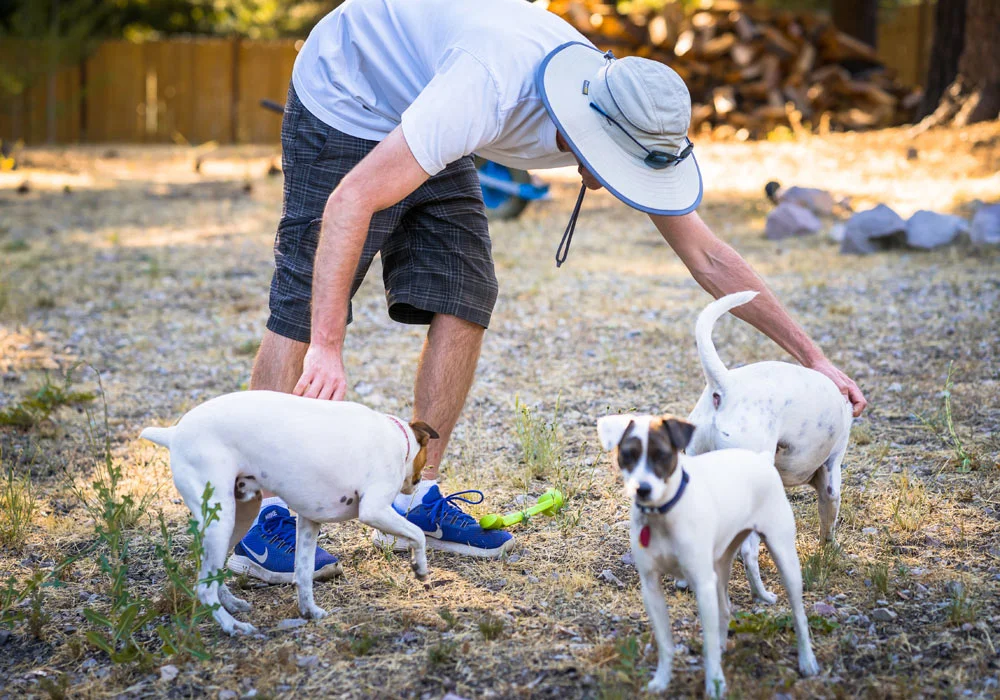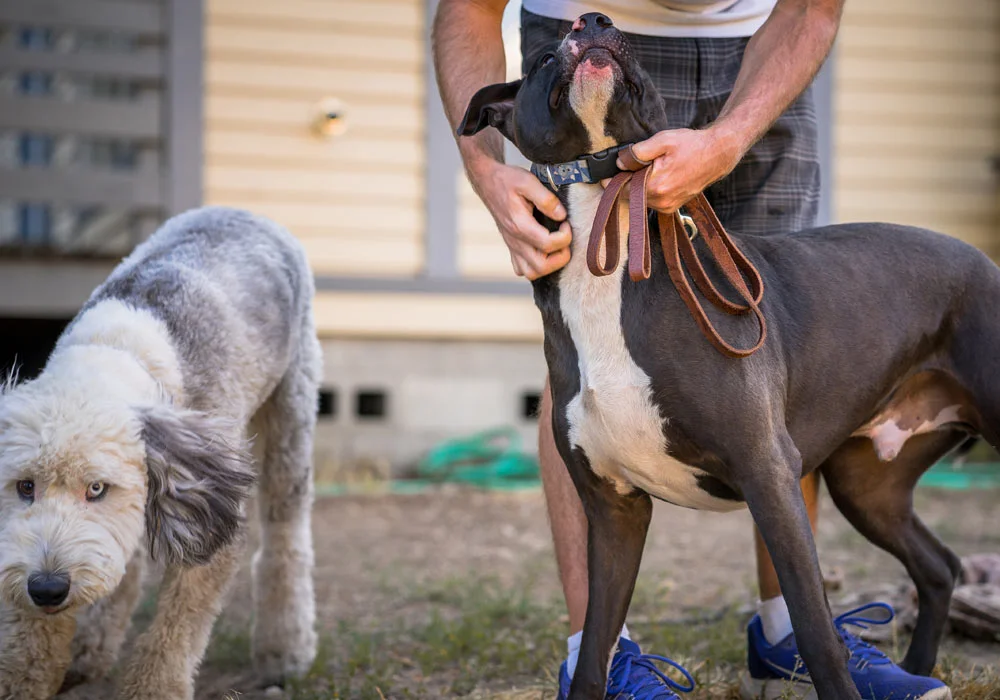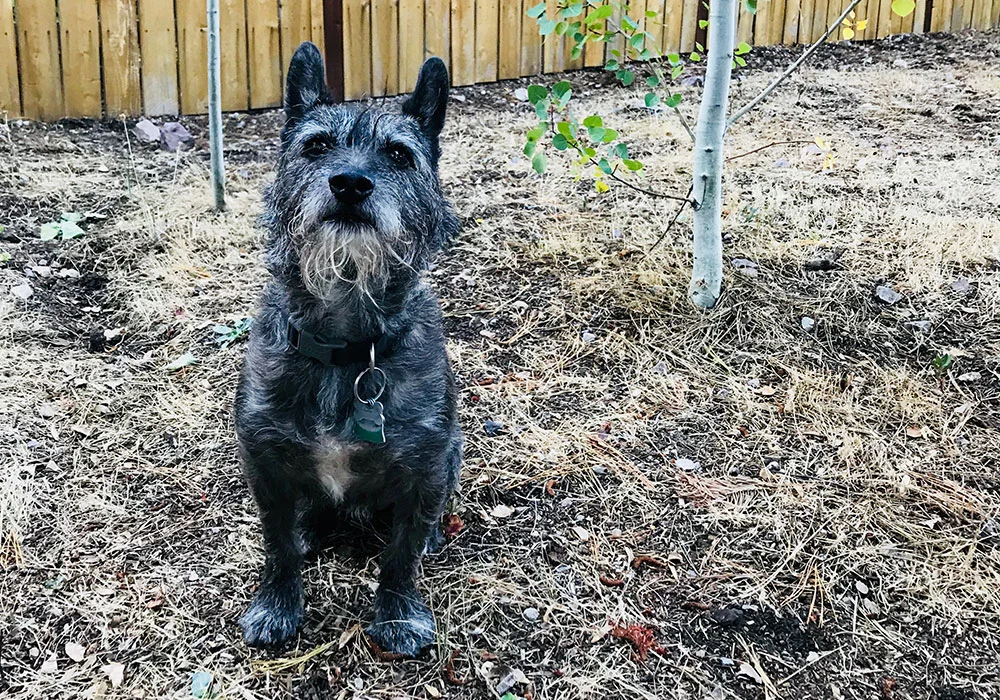
Transformative Training for Lasting Change
At Primal Needs Behavioral Solutions, we utilize transformative dog training techniques that promote lasting behavioral change. Our methods, including Board and Train programs and guest homestay experiences, empower dogs and their owners to build trust and enhance communication.
Our Case Studies
Jax, Lily & Chopper

Owner Testimonial
“Took the dogs for a four-mile off-leash hike, and they are doing amazing! You are a master at what you do. Thanks again, Blair!”
Joe, Roseville, CA
The Challenge
Jax, Lily, and Chopper, three Jack Russell Terriers from the same household, arrived for training, facing significant behavioral challenges. Jax, the father, exhibited human and dog aggression, guarding the doggy door and displaying bullying behavior toward his siblings. The trio struggled with nuisance barking, leash pulling, and poor recall, making outings together nearly impossible. Jax’s aggression occasionally extended to his owners, particularly during moments of affection, while Lily's aggressive barking and Chopper's insecurity added to the complications.
Training Approach
Board and Train Program
To address these issues, we implemented a comprehensive board and training program, complemented by a guest homestay component. The training began with establishing human leadership, ensuring Jax understood that he was no longer in charge. Once this foundation was set, Blair introduced the dogs to a world of structured training, covering both basic and advanced obedience commands.
Hands-On Training Insights
The guest home stay allowed the owners to witness firsthand the training process, gaining vital problem-solving skills and confidence. Special attention was given to Chopper, who needed a gentle approach to build his trust and reduce his fear. Lily proved to be a quick learner, while Jax’s sensitivity to touch required a tailored approach to his training.
Successful Obedience Demonstration
A month later, during the in-home follow-up, all three dogs displayed impressive obedience, remaining in their designated places upon Blair’s arrival. The owners effectively reinforced the training, releasing the dogs one by one as commanded, which showcased their dedication to maintaining the established rules.
Addressing Regression
While there was a slight regression during walks, we quickly addressed these issues, tightening the training and correcting any problems. Since then, the dogs have consistently performed well, and the owners feel empowered to manage their pets confidently, ready to tackle any challenges that may arise.
The Impact of Training
This case study highlights the transformative power of proper training and owner commitment, turning Jax, Lily, and Chopper from a challenging trio into well-behaved companions.
The Story of Wes & Teddy

Background
Wes and Teddy arrived for training from the same household, presenting a range of behavioral challenges that included human and dog aggression, growling, nuisance barking, lack of recall, food aggression, and pulling on the leash. A notable incident involved Wes biting the owner's 15-year-old daughter while she attempted to take away a bone. Originally scheduled for a guest home training program, Teddy’s aggressive barking prompted a shift to a comprehensive board-and-train program to ensure effective training for both dogs.
Training Approach
Blair initiated a 21-day board and train program, emphasizing perception modification before behavioral modification. This approach aimed to alter their pack mentality and establish clear leadership.
- Teddy: At 18 months, Teddy exhibited significant fear due to limited exposure outside his home, compounded by Wes's erratic behavior during walks. Blair focused on building trust with Teddy and gradually introducing him to various stimuli, teaching him to accept rather than react. Through controlled exposure to everyday objects—like trash cans and bicycles—Teddy learned to view the world with confidence.
- Wes: A 75-lb pit bull, Wes had a history of aggressively lunging at people and other dogs. His insecurity stemmed from an unclear leadership dynamic at home. By demonstrating guidance and allowing Wes to relax his protective role, Blair instilled a sense of calm, helping him understand that he did not need to approach every situation with aggression.
Family Involvement
The family, including the parents and their two children, actively participated in the training process, absorbing essential techniques for managing the dogs’ behavior. This collaborative effort ensured that the entire household was prepared for the dogs' return.
Successful Homecoming
Upon returning Wes and Teddy home, the family successfully welcomed friends for the first time in six months—a testament to their progress.
Transforming Guest Interactions
After a recalibrating walk, Blair taught the family proper guest introduction techniques, employing impulse control through the place command. This transformed their home into a safe environment for visitors.
Ongoing Support and Improvement
The family reached out post-training with questions about maintaining their newfound behavior, which led to corrections and improvements in their approach. Remarkably, they began allowing guests into their homes without issue, a stark contrast to their previous isolation.
Confidence in High-Traffic Situations
A month later, Blair checked in and found no lingering issues. The family even inquired about managing the dogs during a homecoming party, highlighting their confidence in handling a high-traffic situation.
Key Takeaways
This case exemplifies the importance of a comprehensive training approach that involves both dogs and their owners. By fostering a balanced relationship and establishing clear rules, both Wes and Teddy successfully transitioned from reactive to relaxed family members. The journey underscores that, with patience and proper guidance, significant behavioral changes are achievable.
Dexter's Transformation

Client Feedback
“Just wanted to say thanks! Dex did great at Thanksgiving, even with unexpected guests and no e-collar at my parents’. My mom wanted to learn how to walk him properly, and he was a perfect, submissive gentleman on and off leash.”
Rebecca, Sacramento, CA
The Challenge
Dexter arrived at Primal Needs Behavioral Solutions facing multiple serious behavioral issues, including human and dog aggression, growling, excessive barking, and food possessiveness. With a history of biting and a fear of abandonment, Dexter was hyperactive and unmanageable. His difficult beginnings—being abandoned at six weeks and lacking early socialization—contributed to his challenges. His first-time owner needed guidance to help Dexter overcome these obstacles.
The Training Approach
To address Dexter's extreme behavior, we implemented a comprehensive board and training program with a guest homestay component.
Establishing Calmness
Blair, our trainer, initiated a calm environment for Dexter during their first meeting, leading to a quiet car ride to the mountains. Initially, Dexter struggled with crate training, throwing tantrums until he learned to see his crate as a safe haven. The first two weeks focused on behavioral training, during which Dexter gradually became comfortable with physical touch and handling.
Positive Behavior Changes
When Dexter's owners joined for their guest home stay, his behavior shifted dramatically. To ensure he received adequate training, Blair extended his program to 8–10 weeks. During their next visit, Blair managed to maintain control of Dexter’s extreme behavior, allowing him to stay overnight with his owners.
Empowering the Owners
In a series of intensive sessions, the owners learned essential skills to meet Dexter's physical and mental needs, grounded in the Primal Hierarchy of Needs. After 15 hours of hands-on training, Dexter returned home with his owners, who were eager to implement their new knowledge.
Follow-Up Success
- First Week: Blair conducted a home visit within 48 hours, reinforcing Dexter’s reintroduction into his home environment. While the transition was smooth, the owners became a bit too eager, prematurely attempting off-leash training before fully absorbing the techniques.
- One Month: The owners struggled with communication using Dexter's electric collar, leading to some missteps during their downtown walks. Blair promptly provided remote support and returned to offer additional training techniques, gradually introducing longer leads to improve Dexter’s proximity awareness.
- Three Months: In the final home visit, all parties exhibited improved communication and behavior. Dexter was thriving, and the owners felt confident in their abilities to manage him.
- One Year Later: A heartfelt message from the owners revealed Dexter's progress.
Transform Your Dog’s Behavior Today
Discover effective behavioral solutions for dogs and empower your furry friend to thrive. Don’t wait—contact us today to book your session or reserve your spot for a transformative training experience!

